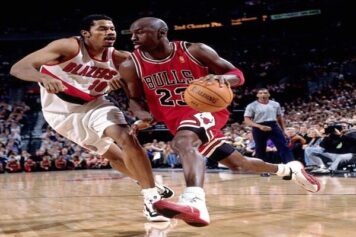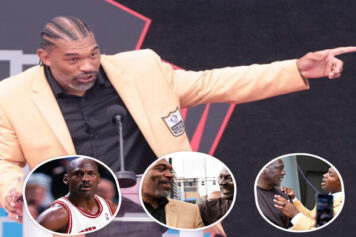In the opening game of tomorrow’s Regional Semifinals, we’ll be treated to a contest between Stanford and Dayton that encapsulates the beauty of the NCAA Tournament. According to the so-called experts, both of these teams were mere salad dressing when the festivities began. But here they are, knuckling up for a chance to advance on to the Elite 8.
Stanford’s victory against Kansas was far from a fluke. If you’ve seen Dwight Powell, Chasson Randle, Josh Huestis and the rest of coach Johnny Dawkins’ team this year, you know that they have the size, talent, toughness and intelligence to compete against anybody.
Despite his pedigree as a former Duke player, and now that he is the coach of one of the country’s most academically rigorous and prestigious institutions, don’t let the smooth flavor fool you.
Dawkins grew up playing ball with his father and three uncles.
“They didn’t cut me any slack,” Dawkins once told the San Jose Mercury News. “But it helped me because I understood how to play the game at a faster pace. I had to play just to survive.”
It was within that crucible that he developed into the mercurial, quicksilver marksman that would one day go on to become one of the greatest guards the college game has ever seen.
His father drove a city bus during the 4:00 AM to noon shift so that he could play ball in the afternoons. Every weekend, Johnny Sr. took his son to the Washington, D.C. playgrounds.
After finishing two summer league games in one day, played in the district’s oppressive heat and humidity, Dawkins would often end up back on the court later that same evening.
“I’d be driving the kids back home at night and Johnny would say, ‘Don’t take me home, just drop me off at Sligo,’” Paul DeStefano, his summer league and high school coach, once told the San Francisco Chronicle. “So I’d drop him at Sligo Park around 9:00 PM, he put his coins in the lights to light up the courts, and he’d shoot until I don’t know when.”
Despite appearing frail as a diminutive freshman playing on the varsity squad at Mackin High School, he was deceptively tough. Dawkins once lit up one opponent for 30 points in one of his first high school games. And that was just in the first half!
By the time he was an upperclassman, he was coveted by every elite institution of higher basketball in the country. Although barely over 6-foot and very thin, Dawkins was a blur on the court: a silky-smooth, left-handed scoring genius. He could shoot from anywhere on the court, possessed an insane handle, great floor vision and had world class speed and stamina. And his flight-game was otherworldly.
During the summer of 1982, before his freshman year in college, ESPN’s current fantastic college hoops analyst Jay Bilas was visiting the nation’s capitol with his parents. Having committed to play at Duke University, Coach K suggested that Bilas stop by Dawkins’ home so the two future teammates could get to know one another.
Bilas knew that Dawkins was the Blue Devils’ heralded recruit, but in the days before the internet, national AAU summer tournaments and sneaker camps, most recruits who weren’t from the same region did not know each other.
“So I called Johnny, and he told me how to get to his house,” Bilas says in Dick Weiss’ book True Blue. “I drove over there and knocked on the door. Johnny answered the door. I didn’t know it was him. I said ‘Hi, I’m looking for Johnny Dawkins.’ Johnny was so slight, that when he answered the door, I asked to speak to his older brother. I figured that couldn’t be him. He looked like a stiff wind could blow him over. He said, ‘I’m Johnny’. And I said, ‘We’re screwed! He’s the savior? He’s the #1 player?’”
Dawkins took Bilas to the playground, where he was the only white player on the court. And it only took a few minutes for him to change his thought process.
“He was awesome, oh my god!” said Bilas. “I had never seen anybody play like him.”
During his first pick-up game at Cameron Indoor Stadium, Dawkins made believers of everyone else when he rammed a gravity-defying, 360-degree dunk in somebody’s face.
In those days, the Atlantic Coast Conference was packing heat like Jimmy Jump in the King of New York.
North Carolina State, with Thurl Bailey, Lorenzo Charles, Sidney Lowe and Derek Whittenburg, won the national championship in 1983. They’d later add Nate McMillan and Chris Washburn.
Ralph Sampson and Othell Wilson were putting in work at the University of Virginia. North Carolina had Sam Perkins and James Worthy playing with some guy named Michael Jordan. At Georgia Tech, head coach Bobby Cremins was constructing a rising power with Bruce Dalrymple, Mark Price and John Salley.
After seeing Dawkins, as a freshman, run a mile in 4:36 with no training and in hi-tops, Duke’s track coach suggested that he could be a world class miler if he put his mind to it.
As a freshman during the 1982-1983 season, Dawkins averaged 18 points, five assists and four rebounds. But Duke lost 17 games. The next year, they finished 3rd in the A.C.C. while he averaged 19 points, four rebounds and four assists.
His junior year, with his buddy from the D.C. area, Tommy Amaker, in his second year running the point, Duke climbed to #2 in the polls during the regular season and won at North Carolina for the first time since 1966.
By his senior year in 1985-1986, Georgia Tech, North Carolina and Duke were all ranked in the top 5. The Blue Devils won the ACC regular season title and the conference tournament championship.
Dawkins opened the NCAA Tournament with 28 points against Mississippi Valley State. In the East Regional final, he dropped another 28 against David Robinson and the Naval Academy, including one of the best in-game dunks I’ve ever seen: a spinning, backwards ram over the head of the Navy defender off the fast break.
He scored 24 against Danny Manning and Kansas in the Final Four, leading the Blue Devils to their 37th victory of the season, which was then an NCAA record.
In the championship game against ‘Never Nervous’ Pervis Ellison, Billy Thopmson, Milt Wagner and the Louisville Cardinals, Dawkins scored 13 of his team’s first 25 points. He connected on 10 of his 19 shot attempts and finished with 24 points. Duke lost what is still considered one of the best title games ever, 72-69, but he definitely lived up to the hype of being a two-time All-American and the National Player of the Year.
“He did things that just made you shake your head,” said Amaker, the current Harvard coach and his former Duke teammate. “He had that incredible dunk, a backwards dunk off a fast break in the regional finals against Navy that many people have talked about over the years.”
After serving as Coach K’s lead assistant for over ten years, where he mentored the likes of Jay Williams, Chris Duhon and JJ Redick, Dawkins, now in his sixth year as the head coach at Stanford, has the Cardinal in their first NCAA Tournament since 2008.
So when you’re watching him coach against Dayton in the regional semifinals, don’t forget that he was THE cornerstone, THE most important basketball player in Duke’s modern history. He took the school from ashy to classy in a few short years, laying the foundation upon which Coach K and the Blue Devils built their empire.
"You could say that Johnny Dawkins was Coach K's most important recruit – maybe even the savior of the Duke program," Dick Vitale once said. "Dawkins' presence changed everything. He took a chance and it paid off in a big way. He was the first great player in the Coach K era and really helped start the Duke dynasty."
“He was kind of like Allen Iverson before Allen Iverson,” Amaker once told the San Jose Mercury News.
If you didn't see him in college, words, even high praise like that, really don’t do the man justice.



